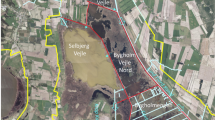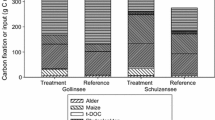Abstract
Sources of nitrogen and phosphorus were measured for a small pool, Brown Moss, which is a Site of Special Scientific Interest in the UK. The site is designated for its macrophyte and bird interest and comprises several pools flanked by heath and woodland. Currently the largest pool has high mean concentrations of total N and P (4 ± 2.4 mg N l−1 and 389 ± 254 μg P l−1), and also suffers from water table fluctuation and recreational impact. There are no point sources of nutrients but potential diffuse sources include direct rainfall, drainage from surrounding heathland and potentially from distal agricultural land, some septic tank drainage and bird excreta. Nutrients are also released from the sediments. Amongst external sources of phosphorus, birds contributed 234 mg m−2 yr−1 (73%), land drainage 63 mg m−2 yr−1 (20%), and rainfall 24 mg m−2 yr−1 (7%). Major bird species were dabbling ducks and geese. For external sources of nitrogen, the most important was land drainage (2,860 mg m−2 yr−1 and 64%), followed by rainfall (870 mg m−2 yr−1 and 19%) and birds (741 mg m−2 yr−1 and 11%) There was substantial internal loading of phosphorus (1670 mg m−2 yr−1) so that internal loading dominated the overall phosphorus budget (84%). The nitrogen budget was dominated by land drainage, though for short periods, geese made a major contribution. Restoration of the site to the status required by European legislation will be very difficult, if not impossible in the medium-term.










Similar content being viewed by others
References
Bales, M., B. Moss, G. Phillips, K. Irvine & J. Stansfield, 1993. The changing ecosystem of a shallow, brackish lake, Hickling Broad, Norfolk, UK. II Long-term trends in water chemistry and ecology and their implications for restoration of the lake. Freshwater Biology 29: 141–165.
Barker, T., K. Hatton, M. O’Connor, L. Connor & B. Moss, 2008. Effects of nitrate load on submerged plant biomass and species richness: results of a mesocosm experiment. Fundamental and Applied Limnology 173: 89–100.
Brandvold, D. K., C. J. Popp & J. A. Brierley, 1976. Waterfowl refuge effect on water quality: chemical and physical parameters. Journal of Water Pollution Control Federation 48: 685–687.
Conover, M. R. & G. G. Chasko, 1985. Nuisance of Canada geese problems in the eastern United States. Wildlife Society Bulletin 13: 228–233.
Don, G. L. & W. F. Donovan, 2002. First Order Estimation of the Nutrient and Bacterial Input from Aquatic Birds to Twelve Rotorua Lakes. Bioresearches, Auckland: 58.
Elser, J. J., M. E. S. Bracken, E. E. Cleland, D. S. Gruner, W. S. Harpole, H. Hillebrand, J. T. Ngai, E. W. Seabloom, J. B. Shurin & J. E. Smith, 2007. Global analysis of nitrogen and phosphorus limitation of primary producers in freshwater, marine and terrestrial ecosystems. Ecology Letters 10: 1135–1142.
Environmental Consultancy, 2001. Meres and Mosses Conservation Plans, Brown Moss. University of Sheffield, Sheffield.
Fredrickson, L. H., 1969. Mortality of coots during severe spring weather. Wilson Bulletin 81(4): 450–458.
Gould, D. J. & M. R. Fletcher, 1978. Gull dropping and their effects on water quality. Water Research 12: 665–672.
Hahn, S., S. Bauer & M. Klaassen, 2007. Estimating the contribution of carnivorous waterbirds to nutrient loading in freshwater habitats. Freshwater Biology 52(12): 2421–2433.
Hameed, H. A., S. Kilinc, S. McGowan & B. Moss, 1999. Physiological tests and bioassays–aids or superfluities to the diagnosis of phytoplankton nutrient limitation? A comparative study in the Broads and Meres of England. European Phycological Journal 34: 253–270.
Hussong, D., J. M. Damaré, R. J. Limpert, W. J. Sladen, R. M. Weiner & R. R. Colwell, 1979. Microbial impact of Canada geese (Branta canadensis) and whistling swans (Cygnus columbianus columbianus) on aquatic ecosystems. Applied Environmental Microbiology 37(1): 14–20.
James, C., J. Fisher & B. Moss, 2003. Nitrogen driven lakes: the Shropshire and Cheshire Meres? Archiv fur Hydrobiologie 2003: 249–266.
Jensen, H. S. & F. O. Andersen, 1992. Importance of temperature, nitrate and pH for phosphorus release from aerobic sediments of four shallow eutrophic lakes. Limnology and Oceanography 73(3): 557–589.
Johnes, P., B. Moss & G. Phillips, 1996. The determination of total nitrogen and total phosphorus concentrations in freshwaters from land use, stock headage and population data: testing of a model for use in conservation and water quality management. Freshwater Biology 36: 451–473.
Johnes, P. J. & A. L. Heathwaite, 1992. A procedure for the simultaneous determination of total nitrogen and total phosphorus in freshwater samples using persulphate microwave digestion. Water Research 26: 1281–1287.
Kilinc, S. & B. Moss, 2002. Whitemere, a lake that defies some conventions about nutrients. Freshwater Biology 47: 207–218.
Kitchell, J. F., D. E. Schindler, B. R. Herwig, D. M. Post, M. H. Olson & M. Oldham, 1999. Nutrient cycling at the landscape scale: the role of diel foraging migrations by geese at the Bosque del Apache National Wildlife Refuge, New Mexico. Limnology and Oceanography 44: 828–836.
Leentvaar, P., 1967. Observations in guanotrophic environments. Hydrobiologia 29: 441–489.
Mackereth, F. J. H., J. Heron & J. F. Talling, 1989. Water Analysis: Some Revised Methods for Limnologists. Freshwater Biological Association, Scientific Publication. No. 36: 120.
Manny, B. A., W. C. Johnson & R. G. Wetzel, 1994. Nutrient additions by waterfowl to lakes and reservoirs: predicting their effects on productivity and water quality. Hydrobiologia 279/280: 133–147.
Migon, C. & V. Sandroni, 1999. Phosphorus in rainwater: partitioning inputs and impact on the surface coastal ocean. Limnology and Oceanography 44(4): 1160–1165.
Moss, B. & R. T. Leah, 1982. Changes in the ecosystem of a guanotrophic and brackish shallow lake in eastern England: potential problems in its restoration. International Review Gesamten Hydrobiology 67: 625–659.
Moss, B., S. McGowan & L. Carvalho, 1994. Determination of phytoplankton crops by top-down and bottom-up mechanisms in a group of English lakes, the West Midland meres. Limnology and Oceanography 39: 1020–1029.
Moss, B., J. Madgwick & G. Phillips, 1996. A guide to the restoration of nutrient- enriched shallow lakes. Environment Agency & Broads Authority, Norwich.
Moss, B., M. Beklioglu, L. Carvalho, S. Kilinc, S. McGowan & D. Stephen, 1997. Vertically-challenged limnology; contrasts between deep and shallow lakes. Hydrobiologia 342/343: 257–267.
Petterson, K., 1998. Mechanisms for internal loading of phosphorus in lakes. Hydrobiologia 373(374): 21–25.
Pettigrew, C. T., B. J. Hann & L. G. Goldsborough, 1998. Waterfowl feces as a source of nutrients to a prairie wetland: responses of microinvertebrates to experimental additions. Hydrobiologia 362: 55–66.
Portnoy, J. W., 1990. Gull contribution of phosphorus and nitrogen to a Cape Cod kettle pond. Hydrobiologia 202: 61–69.
Reynolds, C. S., 1979. The Limnology of the Eutrophic Meres of the Shropshire – Cheshire Plain – A Review. Field Studies Council, Shropshire.
Schindler, D. W., 1977. Evolution of phosphorus limitation in lakes. Science 195: 260–262.
Schindler, D. W., 1978. Factors regulating phytoplankton production and standing crop in the world’s freshwaters. Limnology and Oceanography 23: 478–486.
Smith, R. A., R. B. Alexander & G. E. Schwarz, 2003. Natural background concentrations of nutrients in streams and rivers of the conterminous United States. Environmental Science and Technology 37: 3039–3047.
Søndergaard, M., J. P. Jensen & E. Jeppesen, 1999. Internal phosphorus loading in shallow Danish lakes. Hydrobiologia 408/409: 145–152.
Søndergaard, M., J. P. Jensen & E. Jeppesen, 2003. Role of sediment and internal loading of phosphorus in shallow lakes. Hydrobiologia 506–509: 135–145.
UKTAG, 2007. Recommendations on surface water classification schemes for the purposes of the water framework directive. Environment Agency, Bristol.
Vanni, M. J., 2002. Nutrient cycling by animals in freshwater ecosystems. Annual Review of Ecology and Systematics 33: 341–370.
Young, E. O. & R. D. Briggs, 2005. Shallow ground water nitrate-N and ammonium-N in cropland and riparian buffers. Agriculture Ecosystems and Environment 109: 297–309.
Whild, S., 2007. Detecting Changes in the Aquatic Vegetation of the West Midlands Meres of Great Britain. PhD thesis, The University of Birmingham, Birmingham.
Acknowledgement
RC thanks the Royal Thai Government for a scholarship to work at the School of Biological Sciences, University of Liverpool.
Author information
Authors and Affiliations
Corresponding author
Additional information
Guest editors: M. Meerhoff, M. Beklioglu, R. Burks, F. García-Rodríguez, N. Mazzeo & B. Moss / Structure and Function of World Shallow Lakes: Proceedings from the 6th Shallow Lakes Congress, held in Punta del Este, Uruguay, 23–28 November, 2008
Rights and permissions
About this article
Cite this article
Chaichana, R., Leah, R. & Moss, B. Birds as eutrophicating agents: a nutrient budget for a small lake in a protected area. Hydrobiologia 646, 111–121 (2010). https://doi.org/10.1007/s10750-010-0166-2
Published:
Issue Date:
DOI: https://doi.org/10.1007/s10750-010-0166-2




